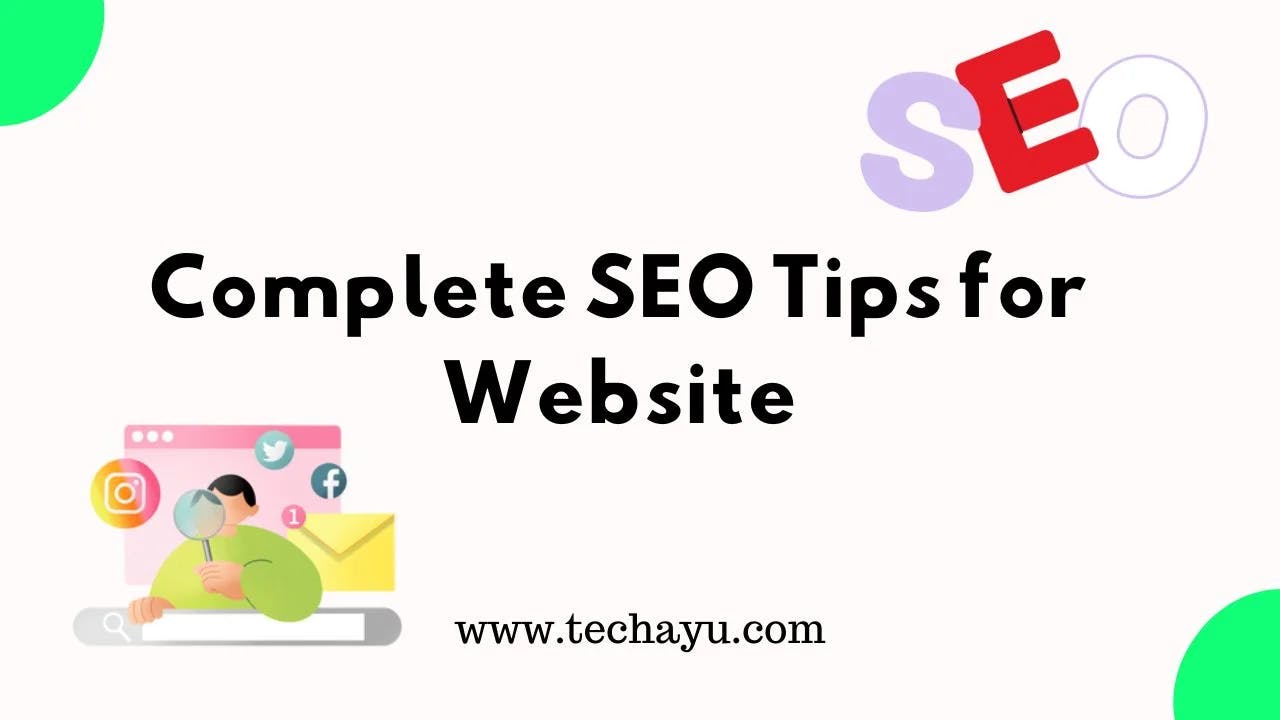
How to do SEO of Website?
Unveiling the Secrets of SEO: A Comprehensive Guide
In the vast digital landscape, where websites compete for attention, SEO stands as the beacon guiding users to their desired destinations. Search Engine Optimization, or SEO, is the art and science of enhancing a website’s visibility on search engine result pages (SERPs). It’s a dynamic field, constantly evolving alongside search engine algorithms. In this guide, we’ll delve into the intricacies of SEO, from its fundamental principles to advanced strategies and future trends.
1. Introduction to SEO
SEO is the cornerstone of online success, enabling businesses to attract organic traffic and engage with their target audience effectively. By optimizing various aspects of a website, SEO aims to improve its ranking on search engine results, thereby increasing visibility and driving relevant traffic.
2. Understanding Search Engine Algorithms
Search engines like Google employ complex algorithms to determine the relevance and authority of web pages. Understanding these algorithms is crucial for devising effective SEO strategies. Factors such as keywords, backlinks, and user experience play significant roles in algorithmic evaluations.
3. Keyword Research and Analysis
Keyword research forms the foundation of SEO. By identifying relevant keywords and phrases, businesses can tailor their content to match user intent effectively. Tools like Google Keyword Planner and SEMrush facilitate comprehensive keyword research and analysis.
4. On-Page SEO Optimization Techniques
4.1 Title Tags and Meta Descriptions
<!DOCTYPE html>
<html lang="en">
<head>
<meta charset="UTF-8">
<meta name="description" content="Your meta description here.">
<title>Your Title Tag Here</title>
</head>
<body>
<!-- Your webpage content here -->
</body>
</html>
Crafting compelling title tags and meta descriptions not only improves click-through rates but also signals relevance to search engines.
4.2 Heading Tags (H1, H2, etc.)
<!DOCTYPE html>
<html lang="en">
<head>
<meta charset="UTF-8">
<title>Your Title Tag Here</title>
</head>
<body>
<h1>Main Heading</h1>
<h2>Subheading</h2>
<!-- Additional headings and content here -->
</body>
</html>
Proper use of heading tags enhances content readability and helps search engines understand the structure and hierarchy of information on a webpage.
4.3 URL Structure Optimization
<!DOCTYPE html>
<html lang="en">
<head>
<meta charset="UTF-8">
<title>Your Title Tag Here</title>
</head>
<body>
<a href="/your-page-url">Link Text</a>
</body>
</html>
Optimizing URL structures for readability and keyword inclusion improves user experience and search engine crawlability.
4.4 Image Optimization
<!DOCTYPE html>
<html lang="en">
<head>
<meta charset="UTF-8">
<title>Your Title Tag Here</title>
</head>
<body>
<img src="your-image-url.jpg" alt="Descriptive Image Description">
</body>
</html>
Image optimization involves using descriptive filenames, alt tags, and compressed file sizes to enhance accessibility and page load speed.
4.5 Content Optimization
<!DOCTYPE html>
<html lang="en">
<head>
<meta charset="UTF-8">
<title>Your Title Tag Here</title>
</head>
<body>
<p>Your optimized content here.</p>
</body>
</html>
Creating high-quality, relevant, and engaging content tailored to user intent is paramount for SEO success.
4.6 Internal Linking Strategies
<!DOCTYPE html>
<html lang="en">
<head>
<meta charset="UTF-8">
<title>Your Title Tag Here</title>
</head>
<body>
<a href="/internal-page">Internal Link</a>
</body>
</html>
Strategic internal linking improves website navigation, distributes link equity, and establishes topical relevance across pages.
These code snippets demonstrate the implementation of various on-page SEO optimization techniques within an HTML document. Incorporating these practices can help improve a webpage’s search engine visibility and user experience.
5. Off-Page SEO Strategies
5.1 Backlink Building Techniques
Earning high-quality backlinks from authoritative websites enhances domain authority and boosts search engine rankings.
5.2 Social Media and SEO
Active engagement on social media platforms amplifies brand visibility and fosters community engagement, indirectly impacting SEO.
5.3 Influencer Outreach for SEO
Collaborating with influencers can expand reach, drive traffic, and earn valuable backlinks, contributing to SEO efforts.
6. Technical SEO Fundamentals
6.1 Website Speed and Performance Optimization
Optimizing website speed and performance improves user experience and positively impacts search engine rankings.
6.2 Mobile Optimization
Given the rise in mobile searches, ensuring mobile responsiveness and usability is essential for SEO success.
6.3 Schema Markup Implementation
Implementing schema markup enhances the visibility of rich snippets in SERPs, improving click-through rates and user engagement.
6.4 Canonicalization and URL Structure
Canonicalization prevents duplicate content issues and consolidates link equity for improved SEO performance.
6.5 XML Sitemaps and Robots.txt
Creating XML sitemaps and configuring robots.txt files facilitates better communication with search engine crawlers, ensuring thorough indexing of website content.
7. Local SEO Tactics for Small Businesses
Local SEO tactics such as optimizing Google My Business listings and garnering positive reviews are crucial for small businesses targeting local audiences.
8. SEO Analytics and Measurement
8.1 Setting Up Google Analytics
Google Analytics provides valuable insights into website traffic, user behavior, and conversion metrics, aiding in SEO performance evaluation.
8.2 Monitoring Key SEO Metrics
Tracking metrics such as organic traffic, keyword rankings, and backlink profile enables informed decision-making and ongoing optimization efforts.
8.3 Using Google Search Console for SEO Insights
Google Search Console offers valuable data on website indexing, search queries, and technical issues, empowering webmasters to address SEO challenges effectively.
9. Advanced SEO Strategies
9.1 Voice Search Optimization
Optimizing content for voice search queries and leveraging structured data markup enhances visibility in voice search results.
9.2 Featured Snippets and Rich Snippets
Optimizing content to appear as featured snippets or rich snippets enhances visibility and drives organic traffic.
9.3 International SEO Best Practices
Implementing hreflang tags, localizing content, and optimizing for multilingual keywords are essential for successful international SEO campaigns.
9.4 SEO for E-commerce Websites
E-commerce SEO strategies such as optimizing product descriptions, implementing schema markup for product listings, and streamlining the checkout process are critical for driving organic traffic and maximizing conversions.
10. Future Trends in SEO
As technology advances, SEO will continue to evolve. Trends such as AI-driven optimization, video and visual search, and enhanced data privacy regulations will shape the future of SEO practices.
11. Conclusion and Next Steps
In conclusion, mastering the art of SEO requires a combination of technical expertise, strategic planning, and continuous adaptation to algorithmic changes and industry trends. By implementing the strategies outlined in this guide and staying abreast of emerging developments, businesses can position themselves for sustained online success.
Embark on your SEO journey today, and unlock the full potential of your online presence!
Stay tuned for more insightful content and practical tips on navigating the ever-changing landscape of digital marketing and SEO.
FAQs (Frequently Asked Questions)
1. What is SEO, and why is it important?
SEO, or Search Engine Optimization, is the process of improving a website’s visibility on search engine result pages (SERPs) to attract organic traffic and engage with the target audience effectively. It’s crucial for businesses as it helps increase visibility, drive relevant traffic, and ultimately, improve online success.
2. How do search engine algorithms work, and why is it essential to understand them?
Search engine algorithms are complex systems used by search engines like Google to determine the relevance and authority of web pages. Understanding these algorithms is vital for devising effective SEO strategies because factors like keywords, backlinks, and user experience play significant roles in how pages are evaluated and ranked.
3. What are some essential on-page SEO techniques?
On-page SEO techniques involve optimizing various elements directly on the website to improve its search engine ranking. These include crafting compelling title tags and meta descriptions, using proper heading tags, optimizing URL structures, image optimization, creating high-quality content, and implementing strategic internal linking.
4. How can businesses improve off-page SEO?
Off-page SEO involves activities carried out outside of the website to improve its search engine ranking. This includes techniques like building high-quality backlinks from authoritative websites, engaging on social media platforms to amplify brand visibility, and collaborating with influencers to expand reach and drive traffic.
5. What are some technical SEO fundamentals?
Technical SEO focuses on optimizing the technical aspects of a website to improve its search engine ranking and visibility. This includes optimizing website speed and performance, ensuring mobile responsiveness, implementing schema markup, canonicalization, creating XML sitemaps, and configuring robots.txt files.
6. How can small businesses leverage local SEO tactics?
Local SEO tactics are essential for small businesses targeting local audiences. These tactics include optimizing Google My Business listings, garnering positive reviews, and ensuring consistency in NAP (Name, Address, Phone number) information across online directories.
7. What are some advanced SEO strategies for future-proofing a website?
Advanced SEO strategies involve optimizing for emerging trends and technologies to stay ahead of the curve. These include voice search optimization, optimizing for featured snippets and rich snippets, implementing international SEO best practices, and tailoring SEO strategies specifically for e-commerce websites.
8. What are some future trends in SEO?
Future trends in SEO include advancements in AI-driven optimization, the rise of video and visual search, and enhanced data privacy regulations shaping the landscape. Staying updated on these trends is crucial for businesses to adapt their SEO strategies accordingly and maintain online success.
9. How can businesses measure SEO performance?
Businesses can measure SEO performance by setting up tools like Google Analytics to track metrics such as organic traffic, keyword rankings, backlink profiles, and user behavior. Additionally, utilizing Google Search Console provides insights into website indexing, search queries, and technical issues that need addressing.
10. What are some next steps after reading this SEO guide?
After reading this SEO guide, businesses can embark on their SEO journey by implementing the strategies outlined, staying abreast of emerging developments, and continuously adapting their strategies to algorithmic changes and industry trends. Regular monitoring of SEO performance and ongoing optimization efforts are key to sustained online success.
